ASUS G74SX: Noteworthy Updates to ASUS' G7 Series
by Jarred Walton on October 6, 2011 12:00 AM ESTBattery Life: No Optimus Makes Me Sad
If there’s one major area where the G74SX falls short, it’s battery life. With no form of switchable graphics, battery life is roughly on par with what we saw from the previous G73 series of notebooks. Alienware uses switchable graphics for their M18x and M17x HD 6970M, and Optimus for the M17x with GTX 580M; both deliver much better mobility off the mains. The Toshiba Qosmio X775 likewise uses Optimus with a paltry 48Wh battery, and even with the battery capacity handicap it still puts up respectable numbers.
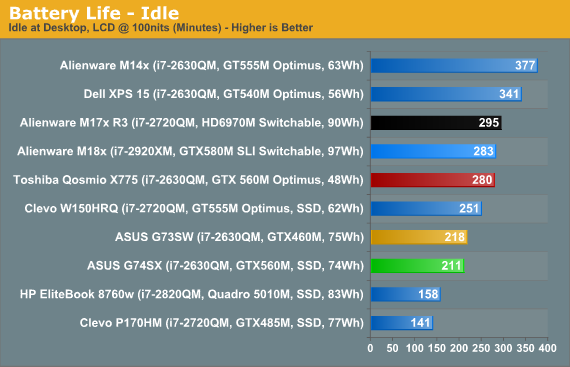
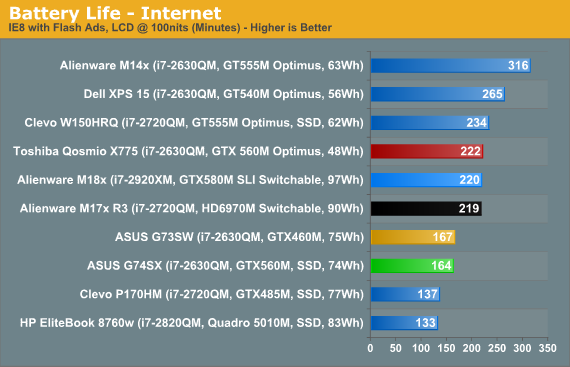
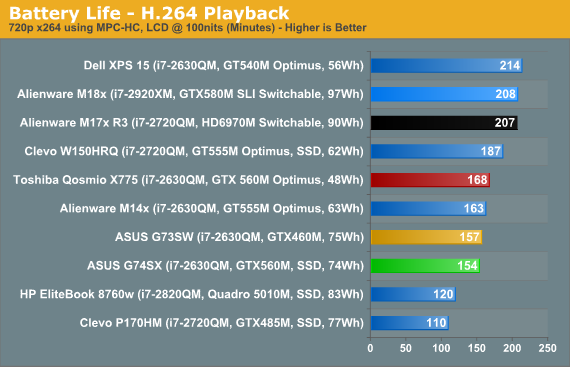
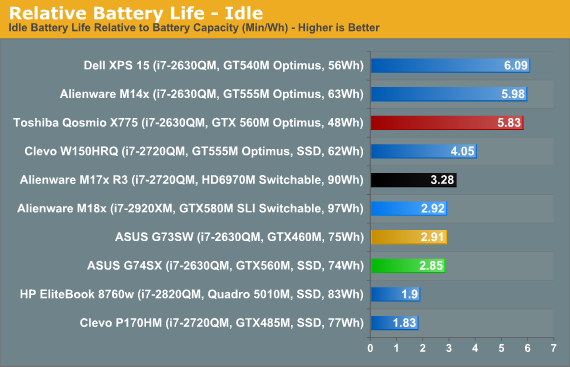
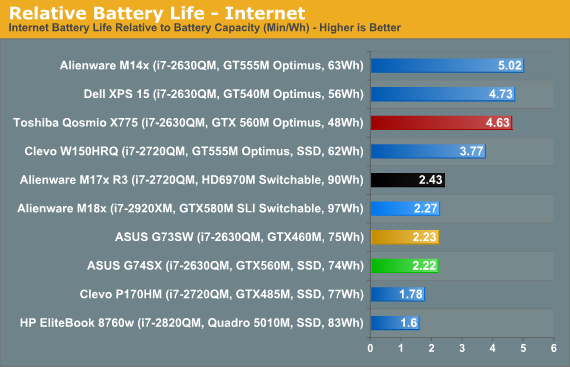
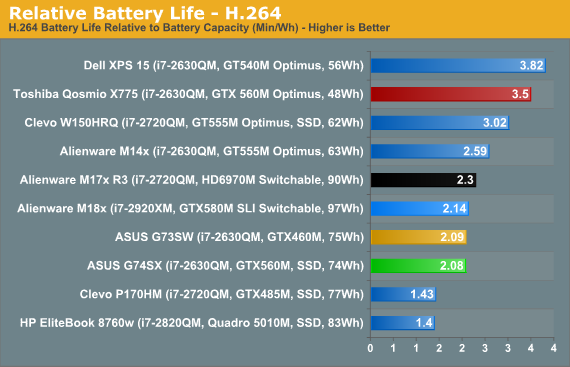
Perhaps the GTX 560M uses a bit more power than the GTX 460M, or maybe the slight change in battery design (and capacity) plays a role. More likely is that the 16GB of memory is also using a bit more power. Whatever the case, battery life is down incrementally relative to the G73SW in all of our tests. You can just squeak past 2.5 hours of H.264 playback or Internet surfing, and around 3.5 hours of idle battery life, but you’ll definitely want to carry the power brick with you whenever you plan on going mobile for more than 90 minutes.
It’s in the relative battery capacity that the Qosmio really shows what Optimus can provide, although to be fair it doesn’t have as much RAM (or SO-DIMMs) to power. Relative battery life is slightly more than double what the G74SX can manage in the idle and Internet tests, and 68% higher in the H.264 result. You do get the “peace of mind” of always using the discrete graphics, no matter the task, but is that enough to sway people to give up battery life? I’m not sure how many feel that way, but I know I’d rather have Optimus and deal with a few idiosyncrasies now and then.










44 Comments
View All Comments
Siorus - Tuesday, October 11, 2011 - link
Unfortunately it doesn't look like I'm going to have time to play around with either system at work anytime soon, so all I can do is relay the information I found when I was trying to deal with it a few months ago.GTA4, GRID, Starcraft 2, WoW and Left 4 Dead 2 are all affected, according to this thread on notebookreview: http://forum.notebookreview.com/asus-gaming-notebo...
And I understand your position on Furmark; there's no arguing that it's a "power virus" so to speak. That said, my personal opinion is that the power supply and cooling systems on these graphics cards should be designed with the absolute worst-case scenario in mind. Limiting board power to keep the card from smoking itself is ridiculous; it's taking the cheap way out rather than beefing up the power supply and the heatsink.
At the risk of going off on a rant (I'll try to keep it short), I see it as symptomatic of a cultural shift; it's evident in plenty of other consumer devices. For instance, I've got a Pioneer SX-1980 stereo receiver. Made in 1978. Linear power supply; the transformer is a toroid around the size of a 50 pack of DVDs; the filter caps are the size of beer cans. It weighs almost 100lbs, and it's rated for 275 watts per channel into 8 ohms. That's continuous power, with both channels driven. The most powerful stereo receiver Pioneer ever made. It will happily put out its rated 550w, 24hrs a day, 7 days a week, from now until the caps dry out or whatever. Almost all modern multichannel receivers will not do that; they are often rated with only 1 channel driven, and "continuous" power quite frequently means for a duration of a handful of seconds or less. A lot of people would consider the SX-1980 to be "overbuilt"; it's not-it's just built to do what the box says it will do, which has become something of an alien concept.
But nobody cares because they don't want to spend any money. People would rather pay $200 for a receiver-or a graphics card-than $300 or $400 for one that's built properly. *shrug*
chinedooo - Saturday, October 8, 2011 - link
ATI does graphics switching so much better than Nvidia. With my dv6t i have the option of using dynamic switching like optimus which switches automatically based on the application, or fixed switching which i switch manually, and it also switches when the laptop is running off battery.JarredWalton - Saturday, October 8, 2011 - link
And the flickering on manual switching is awesome, plus the regular driver updates from AMD... wait, you don't those, do you? I did a whole article on comparing Optimus and AMD Dynamic Switchable; it's not even a close competition:http://www.anandtech.com/show/4839/
darklu - Sunday, October 9, 2011 - link
where is the excellent gt780r by msi in your test?the msi is better than g74 because he had an 570m ^^